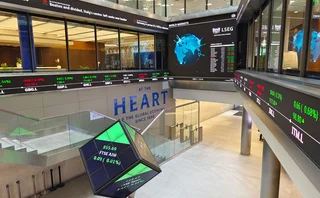
House of the year, Australia: ANZ Bank
Asia Risk Awards 2021
The global pandemic has, in some ways, accelerated the market for sustainable finance investments. The issuance of such products has hit record highs over the past 18 months. ANZ Bank has proven to be a market leader in this space, reaping several sustainability-linked deals in Asia that were the first of their kind, while also leading product innovation among Australian banks.

“Businesses continue to operate through uncertain times across global markets amid the ongoing effects of the pandemic,” says Shayne Collins, head of markets for ANZ.
“At ANZ, we continue to support our customers with the right services and products to ensure they operate smoothly and at optimal capacity. Our international network and market-leading solutions ensure we are well placed to meet the changing demands of our customers and the marketplace.”
When it comes to sustainable finance, ANZ’s dominance in the Australian debt capital and cross-border structuring capabilities puts the bank ahead of its competitors.
“ANZ is the sustainable finance leader in the Asia-Pacific region. We have seen the markets develop from sustainability-linked loans to sustainability-linked bonds, with expected development to sustainability-linked derivatives over time. We are at the forefront of that evolution,” says Paul White, head of capital markets at the bank.
Since 2020, the bank’s sustainable finance team has continued to expand, comprising a global team of more than 20 members with expertise across multiple banking products and industry sectors, as well as technical sustainability knowledge.
“When you bring loan, bond and sustainable finance teams together, it is a strong platform to work with in terms of innovation and origination,” says White.
“We are also very active in cross-border transactions, bringing our domestic clients to Asia and our Asian issuers to Australia and New Zealand.”
Sustainable debt products
ANZ is committed to funding and facilitating at least A$50 billion (US$36.5 billion) in sustainability solutions by October 2025. Over the past year, the bank arranged more than A$70 billion-equivalent of green, social, sustainability and sustainability-linked bonds and loans across Australia, New Zealand and Asia for corporate customers.
In June 2021, ANZ acted as a lead arranger and sustainability co-ordinator for Australian conglomerate Wesfarmers’ A$1 billion dual-tranche sustainability-linked bond (SLB) issuance. The deal constituted the first SLB transaction in Australia’s domestic debt market.
In February 2021, the bank also helped Surbana Jurong, a Singapore-headquartered urban infrastructure and services consultancy, launch the first public SLB issuance in South-east Asia – and the first denominated in Singapore dollars. ANZ received a mandate as joint bookrunner and sole sustainability co-ordinator. The S$250 million (US$185.8 million) SLB deal also underscored the bank’s advisory expertise as it crafted bespoke sustainability framework and sustainability performance targets for the bond that aligned the issuer’s financing, business, and environmental, social and governance objectives.
We have seen the markets develop from sustainability-linked loans to sustainability-linked bonds, with expected development to sustainability-linked derivatives over time. We are at the forefront of that evolution
Paul White, ANZ Bank
These two deals followed the region’s first-ever sustainability-linked notes, issued last December by food and agribusiness Olam International, for which ANZ acted as the sole manager, swaps dealer and sustainability co-ordinator. The ¥7 billion (US$63.6 million) five-year notes were issued to a single investor via private placement.
The next evolutionary step in sustainable finance products is sustainability-linked derivatives (SLDs), which ANZ thinks it is well positioned to bring to market. The bank said it is one of the first Australian banks to provide SLDs to help its customers with sustainability targets and hedging plans.
“Globally, only a handful [of institutions] have executed sustainability-linked derivatives. SLDs are the logical next step in the evolution of the sustainable finance market in the transition to net-zero carbon,” says Damian Underwood, head of market solutions at ANZ.
Risk management capability
As the pandemic disrupted financial markets last year, ANZ worked with the Australian government to uphold market integrity and viability.
The issuance in May 2020 of a record A$19 billion in Treasury bonds at a 1.0% fixed rate, with a December 21, 2030, maturity date, saw ANZ appointed the deal’s hedge and risk manager – in addition to being part of the four-bank mandating group. This was the largest ever syndicated benchmark new issue in Australian dollars at the time, with an order book oversubscribed by three times by a diverse group of global investors.
“We are responsible for not only executing [and] distributing the transaction, but also for managing the hedging and risk. With large transactions, the role of the hedge and risk manager is to ensure the risk is managed smoothly with a stable market backdrop to price the transaction,” says White.
“We have worked as the hedge and risk manager with the AOFM [Australian Office of Financial Management] on two of those government bond issuances in 2020.”
Digitalisation all the way
Looking ahead, the bank says it will continue its digitalisation efforts because fundamental changes in the financial markets brought by the pandemic bode well for its business prospects.
“There is no doubt the Covid-19 situation has accelerated digitalisation in the market and the execution of foreign exchange, rates and credit across platforms. At ANZ, we are fortunate to have an API [application programming interface]-based product strategy, so that we can respond to changing customer and market trends early,” says Luke Marriott, head of electronic fixed income, currencies and commodities at ANZ.
APIs allow applications to access data and interact with external software components, operating systems or microservices.
The bank already has a customer algorithmic execution platform, which – among others – was introduced in February 2019 to provide more tailored client-based solutions, which help ANZ better understand client challenges and needs through data analytics.
ANZ is also currently mapping everything in one system across its institutional banking operations, getting database storage and cloud capacity, and generating the right signals, through artificial intelligence, to help dealers access its platforms more efficiently and provide quantitative strategic solutions for the betterment of its customers.
Only users who have a paid subscription or are part of a corporate subscription are able to print or copy content.
To access these options, along with all other subscription benefits, please contact info@risk.net or view our subscription options here: http://subscriptions.risk.net/subscribe
You are currently unable to print this content. Please contact info@risk.net to find out more.
You are currently unable to copy this content. Please contact info@risk.net to find out more.
Copyright Infopro Digital Limited. All rights reserved.
As outlined in our terms and conditions, https://www.infopro-digital.com/terms-and-conditions/subscriptions/ (point 2.4), printing is limited to a single copy.
If you would like to purchase additional rights please email info@risk.net
Copyright Infopro Digital Limited. All rights reserved.
You may share this content using our article tools. As outlined in our terms and conditions, https://www.infopro-digital.com/terms-and-conditions/subscriptions/ (clause 2.4), an Authorised User may only make one copy of the materials for their own personal use. You must also comply with the restrictions in clause 2.5.
If you would like to purchase additional rights please email info@risk.net
More on Awards
Clearing house of the year: LCH
Risk Awards 2025: LCH outshines rivals in its commitment to innovation and co-operation with clearing members
Best use of machine learning/AI: CompatibL
CompatibL’s groundbreaking use of LLMs for automated trade entry earned the Best use of machine learning/AI award at the 2025 Risk Markets Technology Awards, redefining speed and reliability in what-if analytics
Markets Technology Awards 2025 winners’ review
Vendors jockeying for position in this year’s MTAs, as banks and regulators take aim at counterparty blind spots
Equity derivatives house of the year: Bank of America
Risk Awards 2025: Bank gains plaudits – and profits – with enhanced product range, including new variants of short-vol structures and equity dispersion
Law firm of the year: Linklaters
Risk Awards 2025: Law firm’s work helped buttress markets for credit derivatives, clearing and digital assets
Derivatives house of the year: UBS
Risk Awards 2025: Mega-merger expected to add $1 billion to markets revenues, via 30 integration projects
Interest rate derivatives house of the year: JP Morgan
Risk Awards 2025: Steepener hedges and Spire novations helped clients navigate shifting rates regime
Currency derivatives house of the year: UBS
Risk Awards 2025: Access to wealth management client base helped Swiss bank to recycle volatility and provide accurate pricing for a range of FX structures







